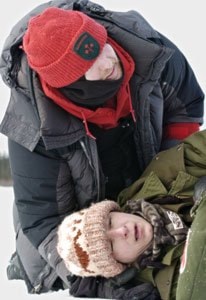Richard Vanderkley lay in the snow on Fish Lake for an hour before help came.
He’d been a passenger aboard a fictional airplane that crashed in the mountains just west of Whitehorse on Friday.
Debris and bodies — some live, some ‘dead’ — were strewn across the length of Fish Lake, as they would be if a small plane full of passengers and cargo had broken apart during a crash landing.
Despite a ‘broken femur,’ Vanderkley wasn’t crying in pain when two Canadian Rangers from Haines Junction arrived on snowmobiles.
“I was just on my way back from Tahiti, and this happens,” he joked as Shane Oakley bound his legs together with metal splints while Bob Reich covered him with a green military parka.
“I’m never flying Southwestern again.”
All three men were Rangers participating in a weekend-long mass training exercise.
The Rangers are class-A Canadian Forces reservists, and the first responders to disasters that happen in the North.
They’re a lightly equipped, mobile group of local men and women who volunteer for first-aid and wilderness-survival training.
You have to own a snowmobile, and be willing to move at a moment’s notice.
Other than that, anyone can become a Ranger. They even get paid a stipend, if they ever put their skills to use.
About 120 Rangers, from Carcross to Carmacks to Beaver Creek, got called to respond to the mock disaster at Fish Lake at 2 p.m.
About 30 Rangers from Haines Junction were the first to arrive.
As Oakley and Reich worked on Vanderkley, their fellows were also busy on the lake, setting up wall tents, determining a perimeter and inspecting immobile shadows on the snow.
Despite the joking banter, they took their jobs seriously. Vanderkley’s fictitious wounds were bound and splinted within minutes.
“Triage is up,” Reich said as he squinted at two tents in the distance that appeared out of nowhere near the lake’s western bank.
“I have to pee,” said Vanderkley.
“Reporters would probably be here by now anyway,” said Oakley. “So grab his head.”
With help, and some comments about “skipping the buffet,” Oakley and Reich hoisted their victim onto a portable stretcher produced from a skimmer that was attached to a snowmobile.
Then they were off to the staging area, where a makeshift morgue and first aid station were already in operation.
There, things were much more serious.
“It’s important to separate the live bodies from the dead ones because of the psychological factor,” explained warrant officer Ken Sollazzo, a veteran Ranger from Yellowknife who co-ordinated the training scenario.
Not far from the makeshift morgue, a lone human figure lay motionless on the snow.
Fatalities are given a lower priority, explained Sollazzo.
From outside appearances, heating was the only discernable difference between the triage tent and the morgue tent.
One had a metal chimney already puffing wood smoke from timber the Rangers cut from the bush. The other was left cold.
“We need signs on those tents,” said Sgt. Wade Istchenko of the Haines Junction patrol, who was “the official person in charge” of the exercise.
Istchenko barked orders as he paced about the staging area, waving a clipboard and weaving in between more than a dozen parked snowmobiles.
He had a no-nonsense approach as a female casualty was brought in, moaning from the pain of her wounds.
“Whose sled is this?” Istchenko asked as soon as the injured woman was offloaded.
“Whose ever it is can go down and get more.”
By 4 p.m. the contingent from Atlin and Carcross had not yet arrived. Those Rangers had mustered at the Canadian Forces base at Mary Lake, and would be coming through the mountains at the south end of Fish Lake.
Meanwhile another group of Rangers was preparing two runways for Twin Otter search-and-rescue planes that would arrive to medevac the wounded in a real emergency.
Others Rangers were sent to Bonneville flats to make landing pads for helicopters.
But there would be no aircraft this time, said Sollozzo.
“We’re working from a base level,” he said.
“This is the first time we’ve done it like this.”
Every year the Rangers take 12 days of training, some involving a mass exercise.
“For the land portion of it, we grouped everyone together so that we can get this start-up of how we’re going to be doing our response to a major air disaster,” said Sollazzo
In the future, the administrators will plan to involve planes and helicopters, he said.
They work in conjunction with local RCMP and emergency measures organizations, taking the lead on search-and rescue-operations.
The Ranger administration tries to make the training scenarios as realistic as possible. Wounds are treated, fires are extinguished and the disaster area is secured from any additional threats.
“What would happen if the crash happened on the side of a mountain?” Sollozzo said, gesturing to the peaks surrounding Fish Lake.
“They’d have to be extracted by helicopter and moved down on gurneys to this location.”
As the sun began setting, Sollazzo got word that the Rangers were setting up generators, to illuminate the disaster site as the work continued through the night.
They would be at it until at least 8 a.m. Saturday, he said.
